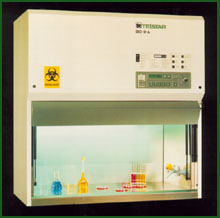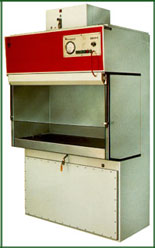- Protection of the product handled
- Biological safety cabins
- Types of cabins
- Class I biological safety cabins
- Class II biological safety cabins
- Class III biological safety cabins
- Choice of biosafety cabins
Protection of the product handled
There are different types of cabinets that provide protection to the product we are handling:
- Horizontal laminar flow cabin
- Vertical laminar flow cabinet with partial recycling
- Vertical laminar flow cabinet with total recycling
In none of these cases is the operator protected, as he is exposed to the airflow that has swept the work area, especially in the horizontal laminar flow cabin.
These types of cabinets only protect the product handled, and not the operator, so that in no case should they be used for the handling of dangerous biological products because they are not biosafety cabinets.

Biological safety cabins
Types of cabins
Class I biological safety cabins

- To work with biological agents of slight or moderate risk (biological agents of groups 1 and 2).
- The use of these cabinets does not guarantee the protection of the product handled or exposure to hazardous materials.
Class II biological safety cabins
They are designed to protect users, to protect the materials handled and also to protect the environment from mild or moderate biological hazards.

Class II type A
In these cabins the volume of air recirculated over the work area is 70% and the remaining 30% is extracted.

Class II type B
In these cabins the volume of air recirculated over the work area is 30% and the remaining 70% is extracted. This type of cabin is also recommended for the handling of highly toxic substances such as carcinogens, and in the preparation of cytostatics.
None of the class II, type A or B biosafety cabinets provide for exposure through contact with infectious materials.
Class III biological safety cabins
These booths are hermetically sealed, completely separating the operator from the work he is doing by physical barriers (completely sealed front panel and manipulation through rubber gloves).
This type of cabin is designed to handle biological agents of risk groups 3 and 4, handling which can only be carried out by trained personnel with specific risk prevention instructions, and offers the maximum level of protection to the product and the operator, as it covers the risk of contact to the maximum extent possible. Therefore, they are also recommended for the handling of highly toxic chemical products when absolute guarantees are required to avoid any direct contact.
Choice of biosafety cabins
| Class I | Class II, Type A | Class II, Type B | Class III | ||
|---|---|---|---|---|---|
| Biological agents | Group 1 | Fully indicated | Fully indicated | Fully indicated | Fully indicated |
| Group 2 | Fully indicated | Fully indicated | Fully indicated | Fully indicated | |
| Group 3 | Not recommend | Can be used | Can be used | Fully indicated | |
| Group 4 | Not recommended | Not recommended | Not recommended | Fully indicated | |
| High toxicity products (carcinogenic, sensitising) | Can be use* | Can be use* | Fully indicated | Fully indicated | |
| *In the event that particles with a diameter of less than 0.3 mm pass through the HEPA filter, the air outside the cabin must be evacuated to the outside and/or a complementary air treatment system must be incorporated. | |||||